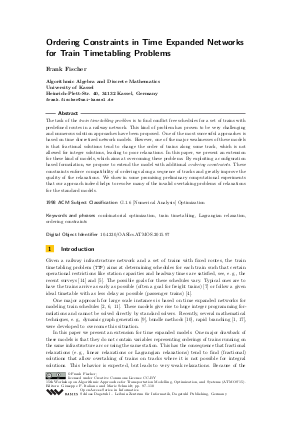Ordering Constraints in Time Expanded Networks for Train Timetabling Problems
Author Frank Fischer
-
Part of:
Volume:
15th Workshop on Algorithmic Approaches for Transportation Modelling, Optimization, and Systems (ATMOS 2015)
Part of: Series: Open Access Series in Informatics (OASIcs)
Part of: Conference: Symposium on Algorithmic Approaches for Transportation Modelling, Optimization, and Systems (ATMOS) - License:
 Creative Commons Attribution 3.0 Unported license
Creative Commons Attribution 3.0 Unported license
- Publication Date: 2015-09-14
File

PDF
OASIcs.ATMOS.2015.97.pdf
- Filesize: 1.18 MB
- 14 pages
Document Identifiers
Subject Classification
Keywords
- combinatorial optimization
- train timetabling
- Lagrangian relaxation
- ordering constraints
Metrics
- Access Statistics
-
Total Accesses (updated on a weekly basis)
0PDF Downloads0Metadata Views
Abstract
The task of the train timetabling problem is to find conflict free schedules for a set of trains with predefined routes in a railway network. This kind of problem has proven to be very challenging and numerous solution approaches have been proposed. One of the most successful approaches is based on time discretized network models. However, one of the major weaknesses of these models is that fractional solutions tend to change the order of trains along some track, which is not allowed for integer solutions, leading to poor relaxations. In this paper, we present an extension for these kind of models, which aims at overcoming these problems. By exploiting a configuration based formulation, we propose to extend the model with additional ordering constraints. These constraints enforce compatibility of orderings along a sequence of tracks and greatly improve the quality of the relaxations. We show in some promising preliminary computational experiments that our approach indeed helps to resolve many of the invalid overtaking problems of relaxations for the standard models.
Cite As Get BibTex
Frank Fischer. Ordering Constraints in Time Expanded Networks for Train Timetabling Problems. In 15th Workshop on Algorithmic Approaches for Transportation Modelling, Optimization, and Systems (ATMOS 2015). Open Access Series in Informatics (OASIcs), Volume 48, pp. 97-110, Schloss Dagstuhl – Leibniz-Zentrum für Informatik (2015)
https://doi.org/10.4230/OASIcs.ATMOS.2015.97
BibTex
@InProceedings{fischer:OASIcs.ATMOS.2015.97,
author = {Fischer, Frank},
title = {{Ordering Constraints in Time Expanded Networks for Train Timetabling Problems}},
booktitle = {15th Workshop on Algorithmic Approaches for Transportation Modelling, Optimization, and Systems (ATMOS 2015)},
pages = {97--110},
series = {Open Access Series in Informatics (OASIcs)},
ISBN = {978-3-939897-99-6},
ISSN = {2190-6807},
year = {2015},
volume = {48},
editor = {Italiano, Giuseppe F. and Schmidt, Marie},
publisher = {Schloss Dagstuhl -- Leibniz-Zentrum f{\"u}r Informatik},
address = {Dagstuhl, Germany},
URL = {https://drops.dagstuhl.de/entities/document/10.4230/OASIcs.ATMOS.2015.97},
URN = {urn:nbn:de:0030-drops-54524},
doi = {10.4230/OASIcs.ATMOS.2015.97},
annote = {Keywords: combinatorial optimization, train timetabling, Lagrangian relaxation, ordering constraints}
}
Author Details
References
- Ralf Borndörfer, Andreas Löbel, Markus Reuther, Thomas Schlechte, and Steffen Weider. Rapid branching. Public Transport, 5(1-2):1-21, 2013. URL: http://dx.doi.org/10.1007/s12469-013-0066-8.
- Ralf Borndörfer and Thomas Schlechte. Models for railway track allocation. In Christian Liebchen, Ravindra K. Ahuja, and Juan A. Mesa, editors, ATMOS 2007 - 7th Workshop on Algorithmic Approaches for Transportation Modeling, Optimization, and Systems, Dagstuhl Seminar Proceedings. Internationales Begegnungs- und Forschungszentrum für Informatik (IBFI), Schloss Dagstuhl, Germany, 2007. URL: http://dx.doi.org/10.4230/OASIcs.ATMOS.2007.1170.
-
U. Brännlund, P. O. Lindberg, A. Nõu, and J. E. Nilsson. Railway timetabling using Lagrangian relaxation. Transportation Science, 32(4):358-369, 1998.

- Valentina Cacchiani, Fabio Furini, and Martin Philip Kidd. Approaches to a real-world train timetabling problem in a railway node. Omega, 58:97-110, 2016. URL: http://dx.doi.org/10.1016/j.omega.2015.04.006.
- Valentina Cacchiani and Paolo Toth. Nominal and robust train timetabling problems. European Journal of Operational Research, 219(3):727-737, 2012. URL: http://dx.doi.org/10.1016/j.ejor.2011.11.003.
-
Alberto Caprara, Matteo Fischetti, and Paolo Toth. Modeling and solving the train timetabling problem. Operations Research, 50(5):851-861, 2002.

- Frank Fischer. Dynamic Graph Generation and an Asynchronous Parallel Bundle Method Motivated by Train Timetabling. PhD thesis, Chemnitz University of Technology, 2013. URL: http://nbn-resolving.de/urn:nbn:de:bsz:ch1-qucosa-118358.
- Frank Fischer. DynG Dynamic Graph Generation library, 2014. URL: http://www.mathematik.uni-kassel.de/~fifr/fossils/dyng.
- Frank Fischer and Christoph Helmberg. Dynamic graph generation for the shortest path problem in time expanded networks. Mathematical Programming A, 143(1-2):257-297, 2014. URL: http://dx.doi.org/10.1007/s10107-012-0610-3.
- Frank Fischer and Christoph Helmberg. A parallel bundle framework for asynchronous subspace optimization of nonsmooth convex functions. SIAM Journal on Optimization, 24(2):795-822, 2014. URL: http://dx.doi.org/10.1137/120865987.
- Frank Fischer, Christoph Helmberg, Jürgen Janßen, and Boris Krostitz. Towards solving very large scale train timetabling problems by Lagrangian relaxation. In Matteo Fischetti and Peter Widmayer, editors, ATMOS 2008 - 8th Workshop on Algorithmic Approaches for Transportation Modeling, Optimization, and Systems, Dagstuhl, Germany, 2008. Schloss Dagstuhl - Leibniz-Zentrum fuer Informatik, Germany. URL: http://dx.doi.org/10.4230/OASIcs.ATMOS.2008.1585.
- Christoph Helmberg. ConicBundle 0.3.11. Fakultät für Mathematik, Technische Universität Chemnitz, 2012. URL: http://www.tu-chemnitz.de/~helmberg/ConicBundle.
-
Jean-Baptiste Hiriart-Urruty and Claude Lemaréchal. Convex Analysis and Minimization Algorithms I &II, volume 305, 306 of Grundlehren der mathematischen Wissenschaften. Springer, Berlin, Heidelberg, 1993.

- Richard M. Lusby, Jesper Larsen, Matthias Ehrgott, and David Ryan. Railway track allocation: models and methods. OR Spectrum, 33(4):843-883, oct 2011. URL: http://dx.doi.org/10.1007/s00291-009-0189-0.
- RAS Problem Solving Competition 2012, 2012. URL: https://www.informs.org/Community/RAS/Problem-Solving-Competition/2012-RAS-Problem-Solving-Competition.
-
Thomas Schlechte. Railway Track Allocation: Models and Algorithms. PhD thesis, TU Berlin, 2012.

- Steffen Weider. Integration of Vehicle and Duty Scheduling in Public Transport. PhD thesis, TU Berlin, 2007. URL: http://opus.kobv.de/tuberlin/volltexte/2007/1624/.
